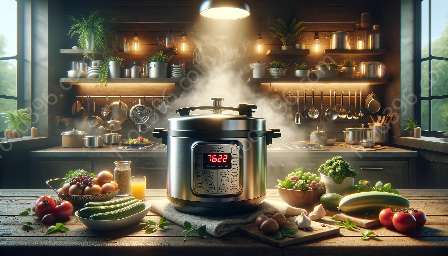Roasting is a cooking method that involves exposing food to dry heat, usually in an oven or over an open flame. It is a versatile and flavorful way to prepare a wide range of foods, from meats and vegetables to nuts and coffee beans. In this comprehensive topic cluster, we'll explore the art and science of roasting, its compatibility with pressure cooking, and various food preparation techniques that can enhance the roasting process.
Understanding Roasting
Roasting is a dry-heat cooking method that uses hot air to surround the food, cooking it evenly on all sides. The high heat helps caramelize the natural sugars in the food, resulting in a rich, complex flavor and appealing browned exterior. Roasting can impart unique aromas and textures to the food, making it a popular choice for creating flavorful dishes.
Types of Roasting
There are two main types of roasting: conventional oven roasting and open-flame roasting. Conventional oven roasting is commonly used for meats, poultry, and vegetables, while open-flame roasting is often employed for specialty dishes such as coffee beans and certain types of nuts.
Roasting Temperature and Time
The ideal roasting temperature and time depend on the type and size of the food being prepared. For instance, large cuts of meat may require a lower temperature and longer cooking time to ensure even cooking, while smaller vegetables may benefit from higher temperatures for a shorter duration to achieve a caramelized exterior while maintaining a tender interior.
Pressure Cooking and Roasting
Pressure cooking can be a complementary cooking method to roasting, as it allows for faster cooking times and can help tenderize tougher cuts of meat. By using a pressure cooker in conjunction with roasting, you can achieve the best of both worlds, preserving the flavors and textures associated with roasting while taking advantage of the efficiency and convenience of pressure cooking.
Enhancing Roasting with Food Preparation Techniques
Food preparation techniques such as marinating, brining, and seasoning play a crucial role in enhancing the flavor and tenderness of foods that are roasted. Marinating meats before roasting can infuse them with additional flavor and help tenderize them, while brining can contribute to moisture retention and flavor enhancement. Additionally, seasoning with herbs, spices, and aromatics can add depth and complexity to the roasting process.
Herbs and Spices for Roasting
From rosemary and thyme to cumin and paprika, the choice of herbs and spices can significantly impact the flavor profile of roasted foods. Understanding how to pair and balance different herbs and spices can elevate the taste of your roasted dishes, creating a sensory experience that delights the palate.
Experimenting with Roasting
Roasting offers endless possibilities for culinary experimentation. Whether you're roasting a whole chicken, a medley of vegetables, or even grains, the process of roasting allows for creativity and exploration. By adjusting variables such as temperature, time, and seasoning, you can tailor your roasting approach to achieve the desired flavor and texture.
Roasting and the Senses
The sensory experience of roasting extends beyond taste and aroma—it also encompasses visual appeal and textural variety. The sight of a beautifully caramelized roast, the enticing aroma that fills the kitchen, and the satisfying crunch or tenderness of the finished dish all contribute to the joy of roasting.
Conclusion
Roasting is a cooking method that combines science and art to create delectable dishes cherished for their depth of flavor and appealing textures. When paired with pressure cooking and enhanced by food preparation techniques, roasting becomes an even more versatile and rewarding culinary practice. By exploring the nuances of roasting and experimenting with different ingredients and methods, you can elevate your cooking skills and delight in the creation of savory, aromatic masterpieces.

